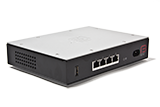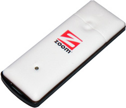Category:FireBrick USB Dongles
Note - installing a dongle
Inserting a SIM into a dongle
To insert a SIM into a Huawei 3G dongle, for example, you will need to have a large-size SIM, so do not pop out a small-size SIM from its enclosing card. You remove a SIM-carrier tray tray from the dongle, fit the SIM into the tray and reinsert it into the dongle.
Configuration and testing
When you plug a usb dongle into the Firebrick, to test if it is working you can use the CLI ‘show dongle’ command in a Telnet session. However, unfortunately this command fails to detect the dongle if <usb> and <dongle> elements have not been added to the XML configuration file. You can at first just add the following to the XML by using the web UI of the Firebrick, under Config > XML Edit:
<usb>
<dongle name="AA" />
</usb>
If you prefer not edit the XML, then you can make the change by using the web UI commands Config > Edit choose ‘Interface’ and then ‘USB and 3G/dongle settings’. Drill down until you see whole lot of options in a number of ‘3G/dongle config settings’ fields. Set the option fields appropriately, at a minimum fill in the ‘Name’ field, and then hit ‘Save’. This will add the <usb> and <dongle> elements for you in the XML configuration.
Following the application of either of these two alternative methods, the CLI ‘show dongle’ command will now work and will detect the presence of the dongle. You will need to fit an appropriate SIM into the dongle. The result will be something like the following:
With no SIM:
> show dongle Attached USB devices -------------------- Socket Vendor Product Name Functions 1 12d1 1003/1003 AA 3G(AT-ppp) You do not have any 3G/ppp sessions You do not have any 4G/eth sessions
And with a 3G SIM installed:
> show dongle Attached USB devices -------------------- Socket Vendor Product Name Functions 1 12d1 1003/1003 Dongle-AA Memory-stick 3G(AT-ppp) 3G/PPP Dongle Sessions ---------------------- Socket T Name MTU Status 1 0 Dongle-AA 1440 Up tcp-fix You do not have any 4G/eth sessions
3G Fallback
The 2700 and 2900 models have a USB port that can be used with a 3G dongle for connectivity and/or fallback. The FireBrick 2500 does not have a USB port. By using a 3G dongle with one or more FTTC/ADSL lines from AAISP you'll be able to fall back to using 3G in the case of the FTTC/ADSL going down - this includes routing of your public IPv4 blocks and IPv6 blocks (IPv6 via a tunnel). Note: 4G dongles may have a problem with routing public IPs to the FireBrick as they act as a NAT device. In these cases using a L2TP tunnel will enable the IPs to be routed.
Working 3G Dongles
Dongles do vary, and drivers may need to be written to support a particular dongle. Contact us if you have one which is not working. The following dongles are known to work on a FireBrick 2700:
- Huawei E156G (Available from AAISP)
- ZOOM model 4598 (Discontinued)
- Huawei E353 (Three branding)
- Huawei E170 (BT Branding)
- Huawei E1752Cu (O2 Branding)
- ZTE MF112 (Three branding)
- Solwise NET-3G-LP1917E (Discontinued)
Working 4G Dongles
- ZTE 823 (O2 branding, or direct from Amazon etc work) — this dongle appears to work "out of the box" for failover, but needs specific configuration if you want to route your IP blocks through it
- Huawei E3372 - cheaper than the ZTE MF823, available from Amazon and others. In ethernet mode (its default) it works with a factory FireBrick configuration. The FireBrick will get an IP address via DHCP from the dongle, eg 192.168.0.123
Unknown not yet working
- Huawei E3272 LTE Surf-Stick (still testing)
- Huawei E3276S-920 (still testing)
- Alcatel One-touch L850 (still testing)
- Alcatel One-Touch 800 (Does not work, seems to only support RNDIS Interface which FireBrick does not support)
Many 4G LTE dongles work by acting as an Ethernet device and perform NAT between the mobile network and the interface presented to the FireBrick. These types of dongles should work OK. If your A&A IP blocks need to be routed to the FireBrick whilst on 4G then using L2TP would be a way to achieve this. We’ll be expanding this section with more details and information as we test further dongles.
A Note on Bonding 3G and 4G LTE SIMs
Multiple USB dongles can used via a USB hub, however the benefits of bonding multiple 3G are small, as you’ll typically be contending with yourself and so there will be little or no added bandwidth. Using multiple dongles with SIMs from different providers may provide extra resilience in the case of one having a problem.
Basic Config
If you have an AAISP data SIM, the FireBrick can be configured to use this as a backup connection, by using a 3G dongle plugged into the USB port. Any routed legacy IPv4 blocks will continue to work across this link, but so far IPv6 isn't supported (without using a tunnel). The example below is all you need to get the dongle configured. If your main broadband connection goes down, the FireBrick will automatically switch to use the 3G connection, then back again once your main connection is back.
<usb>
<dongle username="me@a.2" password="secret"/>
</usb>
Tunneled IPv6 Fallback
If using AAISP, then the options for IPv6 routing on the Control Pages allow an IPv6 block to be routed to a tunnel endpoint if the main routing (i.e. ADSL/FTTC) goes down. This means IPv6 can be routed to the 3G dongle if the main broadband(s) go down. The MTU will be limited though. For more configuration options see FireBrick 2700 Configuration.
Example Config
LAN Interface for IPv6 tunnel over 3G dongle (with MTU 1500):
<interface name="LAN" port="LAN" ra-client="false">
<subnet ip="2001:8b0::1/64 10.0.0.1/24" ra="true" ra-mtu="1480" ra-dns="2001:8b0::2020 2001:8b0::2021"/>
</interface>
LAN Interface for IPv6 tunnel over 3G dongle (with MTU 1492):
<interface name="LAN" port="LAN" ra-client="false">
<subnet ip="2001:8b0::1/64 10.0.0.1/24" ra="true" ra-mtu="1472" ra-dns="2001:8b0::2020 2001:8b0::2021"/>
</interface>
Connect to AAISP over PPPoE session (3G dongle tweaks and NAT):
<ppp name="AAISP" port="WAN" username="me@a.1" password="secret" nat="true" lcp-rate="1" lcp-timeout="5" graph="AAISP" log="default"/>
Connect to AAISP over 3G dongle (with NAT):
<dongle name="AAISP-3G" username="me@a.2" password="secret" nat="true" graph="AAISP-3G" log="default"/>
3G dongle IPv6 default route using IPv4 tunnel:
<route ip="::/0" gateway="81.187.81.6" comment="IPv6 default route using IPv4 tunnel"/>
Turning the dongle off outside of office hours
Sometimes we don't want the dongle to be online 24x7 and want it turned off outside of office hours.
This example brings the dongle online for quick fallback during office hours, and leaves it powered up but disconnected.
Fallback still works outside of office hours but takes a few seconds longer to set up.
Note that both <usb> and <dongle> elements can be conditional, based on profiles.
Leaving <usb> active but disabling <dongle> will leave the dongle powered up but disconnected.
Disabling <usb> will physically turn off the USB port and therefore also the dongle.
Cold starts take a lot longer!
<usb>
<dongle name="AAISP-3G" username="me@a.3" password="secret" graph="AAISP-3G" profile="AAISP-3G"/>
</usb>
<profile name="Office-Hours" comment="Office hours">
<time days="Mon Tue Wed Thu Fri" start="08:00:00" stop="18:00:00"/>
</profile>
<profile name="No-DSL" ppp="ADSL1 ADSL2" invert="true"/>
<profile name="AAISP-3G" or="Office-Hours No-DSL" comment="Backup active during office hours, or if there is no DSL outside of office hours"/>
This example is taken from a site which has 2 ADSL lines - hence the No-DSL profile being based on ADSL1 and ADSL2 being up. The AAISP-3G profile is then active during office hours, but it will become active if both of the ADSL lines are down outside of office hours.
Ping test example of falling back
Here we ping an IP on the LAN, behind the FB2700, and get the ADSL router to re-sync. The ADSL went down, the 3G kicked in with only a single ping lost, then shortly after the ADSL came back on and took over the routing again.
64 bytes from 81.187.xx.xxx: icmp_req=120 ttl=57 time=17.6 ms 64 bytes from 81.187.xx.xxx: icmp_req=121 ttl=57 time=18.1 ms 64 bytes from 81.187.xx.xxx: icmp_req=122 ttl=57 time=17.0 ms 64 bytes from 81.187.xx.xxx: icmp_req=123 ttl=57 time=20.4 ms 64 bytes from 81.187.xx.xxx: icmp_req=124 ttl=57 time=17.3 ms 64 bytes from 81.187.xx.xxx: icmp_req=125 ttl=57 time=17.2 ms 64 bytes from 81.187.xx.xxx: icmp_req=126 ttl=57 time=17.3 ms From 90.155.53.12 icmp_seq=132 Time to live exceeded 64 bytes from 81.187.xx.xxx: icmp_req=133 ttl=57 time=792 ms <- Now on 3G 64 bytes from 81.187.xx.xxx: icmp_req=134 ttl=57 time=291 ms 64 bytes from 81.187.xx.xxx: icmp_req=135 ttl=57 time=451 ms 64 bytes from 81.187.xx.xxx: icmp_req=136 ttl=57 time=426 ms 64 bytes from 81.187.xx.xxx: icmp_req=137 ttl=57 time=338 ms Some successful pings omitted as it took a while to sync again. 64 bytes from 81.187.xx.xxx: icmp_req=180 ttl=57 time=176 ms 64 bytes from 81.187.xx.xxx: icmp_req=181 ttl=57 time=276 ms 64 bytes from 81.187.xx.xxx: icmp_req=182 ttl=57 time=216 ms 64 bytes from 81.187.xx.xxx: icmp_req=183 ttl=57 time=174 ms 64 bytes from 81.187.xx.xxx: icmp_req=184 ttl=57 time=212 ms 64 bytes from 81.187.xx.xxx: icmp_req=187 ttl=57 time=16.3 ms <- Now back on ADSL! 64 bytes from 81.187.xx.xxx: icmp_req=188 ttl=57 time=16.5 ms 64 bytes from 81.187.xx.xxx: icmp_req=189 ttl=57 time=16.2 ms 64 bytes from 81.187.xx.xxx: icmp_req=190 ttl=57 time=16.5 ms 64 bytes from 81.187.xx.xxx: icmp_req=191 ttl=57 time=16.6 ms 64 bytes from 81.187.xx.xxx: icmp_req=192 ttl=57 time=16.0 ms 64 bytes from 81.187.xx.xxx: icmp_req=193 ttl=57 time=16.8 ms
You can tell when the swap over happened as the latency increases and then decreases again when the DSL came back online.
Telnet Commands
Reset the USB controller and re-detect everything from scratch:
clear usb
Show dongle information:
show dongle
Pages in category "FireBrick USB Dongles"
This category contains only the following page.

